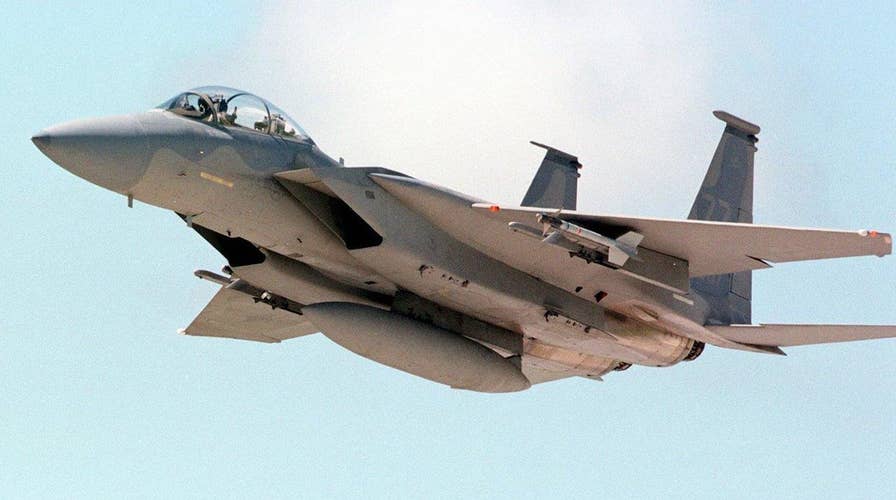Keane: ISIS airstrikes are a good thing but can't win a war
Retired general weighs in on U.S. targeting Islamic State in Libya
The United States launched a new round of airstrikes against Islamic State militants in Libya on Monday, Pentagon officials confirmed, opening a more persistent front against the terror group that had no specific "end point" as long as the fragile Libyan government needed U.S. help.
President Obama authorized the strikes after the United Nations-backed Libyan government made its first request for this type of aid, the Pentagon said. It marked the third round of U.S. strikes in Libya since November.
"I don't want to predict the pace" of any future strikes, Pentagon Press Secretary Peter Cook told reporters at a news briefing. He denied the U.S. was leading from behind, describing the strikes as "providing military support for a partner on the ground."
Fayez Serraj, the head of the U.N.-brokered presidency council, said in a televised statement that American warplanes attacked the ISIS bastion of Sirte, "causing major casualties," adding that no U.S. ground forces were deployed. The precision strikes targeted an ISIS tank and two vehicles, officials said.
Cook said the U.S. would vet its specific targets as part of a "collaborative process" with the Libyan government. He also said the two nations would share intelligence and surveillance.
The number of ISIS fighters in Libya has grown over the past year to more than 5,000, according to estimates, although the United Nations reported that many of those fighters may have left Sirte over that time frame. Sirte represents the terror group's only remaining stronghold along Libya's northern coast.
"[The strikes] are consistent with our approach to combating ISIL by working with capable and motivated local forces," Cook said. "These actions and those we have taken previously will help deny ISIL a safe haven in Libya from which it could attack the United States and our allies."
Libya slid into chaos after the 2011 ouster of Moammar Qaddafi and has in the past years become bitterly divided between rival factions and competing governments. Top Pentagon officials have repeatedly said that while ISIS is getting squeezed in Iraq and Syria, the group will spread out and find safe haven.
For months, top Pentagon officials have said they would wait for a new government in Libya before ramping up operations against ISIS there. Pentagon officials confirmed recently that teams of special operations forces had been going in and out of Libya in the past few months to meet local forces on the ground.
Cook would not reveal what type of U.S. military aircraft were used in Monday's strikes. The U.S. military has been flying armed drones out of Sicily since this past winter.
In February, U.S. Air Force F-15s flying out of the United Kingdom bombed an ISIS training camp outside the Libyan capital of Tripoli killing up to 50 ISIS fighters.
In November, one day after the attacks in Paris that killed more than 125 people, U.S. jets killed the top ISIS leader in Libya, Abu Nabil, in the port city of Darhna. Nabil was a longtime Al Qaeda operative before leading the ISIS affiliate in Libya.
U.N. Secretary-General Ban Ki-moon said on July 19 that ISIS fighters in Libya were facing the "distinct possibility" of defeat in their last stronghold and were likely to scatter elsewhere in the North African country and the region.
Ban said one member state recently reported between 3,000 and 4,000 ISIS fighters in Sirte.
But he said as a result of the recent offensive against ISIS, by forces aligned with the U.N.-brokered government and others, "the current number of those in Sirte is now likely well under 1,000," with large numbers of those who have recently fled the city likely relocating and regrouping "in smaller and geographically dispersed cells throughout Libya and in neighboring countries."
According to one unnamed U.N. member state, Ban said dozens of Tunisians fighting for ISIS already returned home "with the intent to conduct attacks."
The secretary-general said the current political divide in Libya continued to make the country attractive for foreign fighters who are actively recruited by ISIS and Al Qaeda-linked groups to boost their military capabilities.
Since 2014, Libya has been split between rival governments and parliaments based in the western and eastern regions, each backed by different militias and tribes. A U.N.-brokered deal in December to create a unity government has reached a deadlock, due to political jockeying and the new government's inability to put together an action plan to provide basic services.
Ban said ISIS propaganda in March 2015 and again in April 2016 called for supporters to travel to Libya instead of Iraq or Syria. He said the largest group of foreign fighters currently operating in Libya are individuals linked to ISIS, and they dominate the extremist group's top leadership.
Foreign fighters have also joined Al Qaeda in the Islamic Maghreb which periodically infiltrates Libya and uses the country as a rest stop and for training and buying arms, he said.
Another prominent group of foreign fighters in Libya are members of Ansar Al-Sharia in Tunisia, another Al Qaeda affiliate, which continues to train its forces in Libya near the Tunisian border, the secretary-general said.
Fox News' Lucas Tomlinson and The Associated Press contributed to this report.

